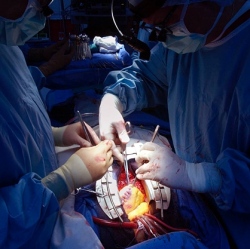
We’re much better at saving the lives of those who suffer a heart attack these days. Sadly, many people survive a heart attack only to later succumb to heart failure from the damage it caused.
Modern methods help heal the heart somewhat after a heart attack, but cardiologists think stem cell therapy might one day offer a far superior alternative.
Stem cells aren’t just good for growing new organs, they can also heal old or damaged ones from the inside. Thousands of patients whose hearts were damaged in a heart attack have undergone some form of stem cell therapy worldwide, and the results are promising. But there’s a problem. Once in the heart, the cells don’t tend to stay put.
Dr. W. Robert Taylor, professor of medicine at Emory and Georgia Tech and director of Emory’s cardiology division, recently co-authored a paper on a new technique that may significantly increase the efficacy of stem cell therapy in the heart.
The new procedure, tested in mice, encapsulates stem cells in alginate, a gummy substance derived from algae and used widely (and safely) in human products. Thus confined, the cells stick around longer and deliver greater healing to the heart muscle.
Dr. Taylor told Singularity Hub that current methods attempt to repair damaged parts of the heart by reintroducing blood flow using stents, surgery, or clot-busting drugs.
